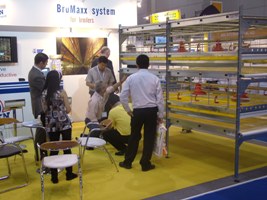VIV Asia is the place to be

From March 7-9, the VIV Asia tradeshow took place in the Thai capital Bangkok. A large crowd of visitors, primarily from Asia, came to the show in the BITEC exhibition centre to meet with the many exhibitors that were on display, resulting in excellent business contacts. This is logical. After all, Asia is the place to be.
By Ad Bal
VIV Asia featured three new special themes: Feedtech-Croptech Asia, LAB@VIV Asia and ChinaVisions. There was also an extensive conference programme with in-depth coverage of all the sectors of the exhibition, with a special focus on Bioenergy. For three days, Feedtech-Croptech Asia truly was the centre of the Asia-Pacific milling industries. LAB@VIV Asia effectively targeted the feed and food laboratory business. ChinaVisions was the international summit for the Chinese animal production and processing industries. Moderated by Gordon Butland from Thailand, major issues on the pork and poultry situation on the Chinese market were addressed by MA Chuang of the China Animal Agriculture Association.
Although broiler cages are not a new phenomenon, quite a few suppliers of housing systems had these cages on display at VIV Asia. Due to legislation and welfare issues, broiler cages are not allowed in the EU, but in many other countries there’s a good demand for it. Broiler cages offer various advantages. Firstly, the house can be used more effectively since more birds can be kept per square meter. Depending on the final growing weight andwhether 3 or 4 tier batteries are used, the number of birds can be two to three times more, compared to conventional systems.
Compatible cargo system
VIV Asia is not really the platform for introducing new products. Yet a few innovative products were on display. Such as the new HatchCargoSystem (HCS) of Twinpack. This is a patented way of stacking trays, meaning there is no need for the use of metal trolleys any more. HCS trays contain 150 eggs each and have several advantages in transport. The trays can easily be stacked and unstacked due to their construction and can load up to 40% more eggs on the same floor size compared to the metal trolleys.
According to show organisers VNU Exhibitions from the Netherlands and NEO from Thailand, VIV Asia has proved to be an excellent venue for the animal protein business. During the show in Bangkok, both organisations announced that together they will also start organising VIV Ildex India in February 2012 in Bangalore India. Thus far, both NEO and VNU organised their own shows, but now they have teamed up to organise one biannual event together. Also the outlook for VIV Asia 2013 is sunny. A third of the exhibitors at this years event have registered already for the next edition which is scheduled for 13-15 March, again at BITEC in Bangkok.
MORE INFORMATION |
Ten year outlook “Feed prices are here to stay, Brazil’s corn potential could grow faster, Russia will soon become self-sufficient with regard to pig and poultry production and China will most likely face large grain imports.” In short, these were some of the key elements of the presentation of David C. Nelson, global strategist, Animal Protein, Grains & Oil Seeds at the official opening of VIV Asia. His topic was ‘Focus 2021’ an attempt to look ten years into the future for global agriculture in general, and Asian agriculture in particular.Feed prices will remain high, Nelson said, as yield improvements are decelerating and the challenge remains to service growing markets. One of the countries that could well profit from this growth could be Brazil, he said. The country had, however, increased its total surface of planted crops by a mere 1% in 2010-2011. Input costs, fertiliser prices, land prices and an unfavourable currency were named as reasons why the message to grow more crops in Brazil was not yet taken up. Nelson also compared Brazil’s Mato Grosso province to the Black Sea region in Ukraine/Russia. Both have high potential, but are relatively landlocked and badly reachable – hence high transport costs need to be added to relatively low costs of cultivation. At the moment, JBS, Tyson and Smithfield top the ranks of largest meat producers in the world. These companies will be challenged, Nelson mentioned. The last couple of years already saw the rise of the Brazilian conglomerates, and the size of Russian and Chinese integrators is growing rapidly.Russia’s official policy is to become self-sufficient in protein production, i.e. domestic production will meet domestic demand. Nelson expected Russia to be at 85% in 2015 and at 95% in 2020. “What this means? All meat exporting countries have to find new markets!” |













